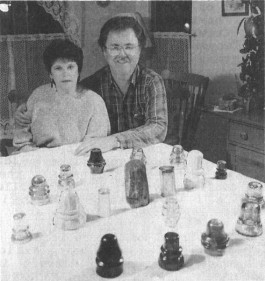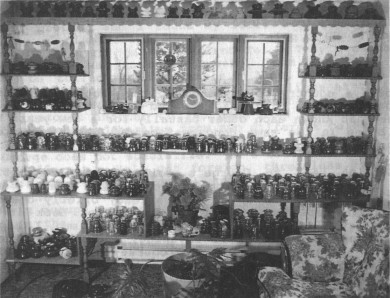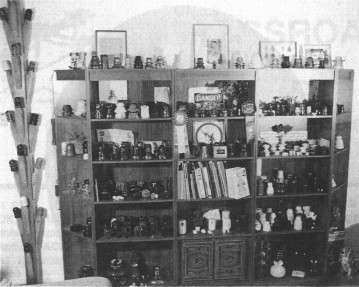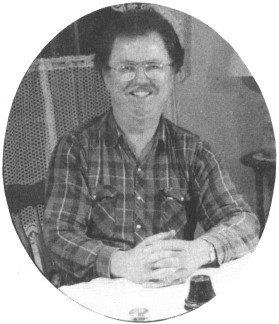Bea Lines
by H.G. "Bea" Hyve
Reprinted from "Crown Jewels of the Wire", June 1989, page 12
Let's go to Canada this time, eh? This will be "Bea Lines'" first
foreign interview. However, to readers in Canada, it won't be foreign; just to
the rest of us. We are talking this time with George Kammerer (whose last name
rhymes with "hammerer".)
George and his wife Ghislaine (pronounced "Jis-lane'") live in
Dunham, Quebec, where he earns his living as a sign painter. He is the collector
in the family, and says that collecting insulators has been a lifelong affair
for him. When he was a small boy, he loved seeing the green or aqua colored
glass insulators in use on the lines, never dreaming that one day he'd become a
collector. That was some thirty-five or forty years ago. "Ghislaine",
says George, "must be interested in insulators. Why else would she bother
to dust then off from time to tine? Seriously, she approves of the hobby, and
she is proud to show then off to others who visit us.
"My interest in collecting insulators was kindled back about 1954 when
we were on our farm out in the 'boonies'. My older brother and I found my first
two 'jewels' in the woodshed. I distinctly remember one being a CD 145 beehive
and the other a CD 104 New England Tel & Tel, arc-embossed, which I'm sure
was in olive green! From then on I was a 'goner' on collecting insulators. Also,
I think I'm one of the first collectors ever to walk the lines at that time.
There was an abandoned railway track that passed nearby. There I rescued another
CD 145 aqua plus a white porcelain CPR incuse-embossed beehive from two
different poles."
George does not specialize. He's interested in anything that's different.
He's got foreign, threadless, non-glass, non-porcelain, wire holders, spools,
and strains; quite an assortment. As might be expected, Canadian glass and
porcelain occupy a fairly large part of George's collection. He likes the
Diamond Glass Company insulators and thinks that he will always hold on to them,
even if he decided to sell his collection. He's got a few metal signs, plus an
authentic telegram dating back to 1886 from the Great North Western Telegraph
Company of Canada. He used it in a display recently in Canada.

Ghislaine and George Kammerer with
some of his threadless insulators
Left to right, front to back: Row 1: CD 731
Tillotson, deep cobalt blue; CD
735 U.P.R.R., teal blue; CD 719, nice light blue; CD 742 NN, aqua; CD 740 NN,
aqua. Row 2: CD 700 "egg". Row 3: CD 734 McMicking; "horned" Elliott; CD 721, pale green; CD 722 (723?) Wade, weathered
but nice; CD 722 (723?), aqua; Elliott "stovepipe"; CD 742.5 Battleford
Baby, blackglass. Row 4: CD 729.1 NN, aqua; CD 735 U.P.R.R., aqua; CD 701 NN, emerald green; CD 731
NN, aqua; CD 728 NN, aqua, with top part of pin inside (removable).
We'll get back to George's collections in a minute, but first let's find out
a bit about him. He was born in Montreal June 27, 1943. But from his tenth year
onward,
he's been a country boy. He "tied the knot" with Ghislaine on June
19, 1982. They had started going together in 1981, but they had known each other
casually for a few years before that, being in the same congregation of
Jehovah's Witnesses in Cowansville, six miles from Dunham.
Getting back to George's collections, he continues, "I've had two
different collections. The first one was when I was young, and which I've
already briefly described. After having abandoned my first collection back in
1960, I got started again in 1978. And this time, I began to get my hands on
just about anything, including items that I'd never dreamed existed! Of course,
now I had to buy almost everything I own. Also, it's now evolved into a
recognized hobby; no longer a haphazard gathering together of whatever comes
along." Presently, George has five hundred ninety-eight insulators in his
house. He says that compared to others in the hobby, that's a rather modest
amount, but he has a great deal of variety in his collection.
For about four or five years, George was very interested in antique cars,
having owned two of them himself. One was a 1956 Ford Crown Victoria hardtop and
the other was a 1951 Mercury "woodie" wagon. He displayed those a few times at
an eastern antique car meet before finally selling them. In these days of
"tight money", he says he doesn't feel that he can afford such
luxuries.
George continues, "On my garage walls I display an extensive collection
of auto license plates from all over the United States and Canada, plus a few
from overseas for good measure; about four hundred fifty in all. I call it my
metal 'wallpaper'! These get quite a lot of comments from people walking into
the garage for the first time. However, I don't consider myself an active
collector anymore. In the late 1970's I was picking up both insulators and plates
regularly at flea markets or elsewhere.
"Of course, I'm proud of my collection of threadless insulators, all
eighteen of them! Being a 'low-bucks collector, I don't have the money to
invest in high-priced goodies. Remember also that I'm a CANADIAN collector; if I
buy expensive items across the border, I pay in U. S. funds, not Canadian. The
exchange therefore can be quite steep. This becomes expensive when the monetary
exchange is added to the purchase price. From time to time I've found the odd
bargain at insulator shows. To me, threadless insulators are HISTORY, pure and
simple. I've always liked history, old objects of interest; and threadless
insulators fit in there perfectly.

Part of George's glass and porcelain collection

More glass and porcelain insulators
"There are two glass and two porcelain threadless pieces in reasonably
good shape that I've gotten at 'budget' prices because of being repaired but still in good displayable condition. For
instance, when we went to the Bakersfield show in October, 1983, I spotted a CD
731 Tillotson in dark cobalt blue on Grant Salzman's table. It had been broken
and repaired, and there is still a small chunk gone out of the base. Fortunately
it's more on the inside than out. Only when I got hone did I wonder if that
insulator had been sold or not. I didn't buy it at the show because I had a
limited amount of U. S. currency on me to get us back to the Los Angeles airport
to catch the plane back to Vancouver, B. C. Some time later, I phoned Grant to
ask him about the Tillotson. Yes indeed, it was still available and I could have
it for a very modest sum. He packed it carefully, and later on it came into my
hands. I was a happy guy and I imagine that Grant was just as content; that's
the way insulator people are."
In conclusion George states, "It would be thrilling to go out and
discover something really unique, either buried in the ground, or sitting on a
shelf in a junk shop gathering dust. To most people in this hobby, this means
threadless glass, but there are some desirable porcelains that I'd like to get
my hands on, such as a U-990 'teapot'. I believe that the fun is in hoping to
make that great 'find' someday. Otherwise, it tends to make you lose interest,
when you feel that you have everything under the sun."
I corresponded with George for a long time before I finally got to meet him.
We've talked at both the St. Charles and Saratoga Springs nationals, and he is
a very friendly individual, and delightful to meet. George is the first of many
other "foreign" collectors I hope to interview in the future.

George
|
